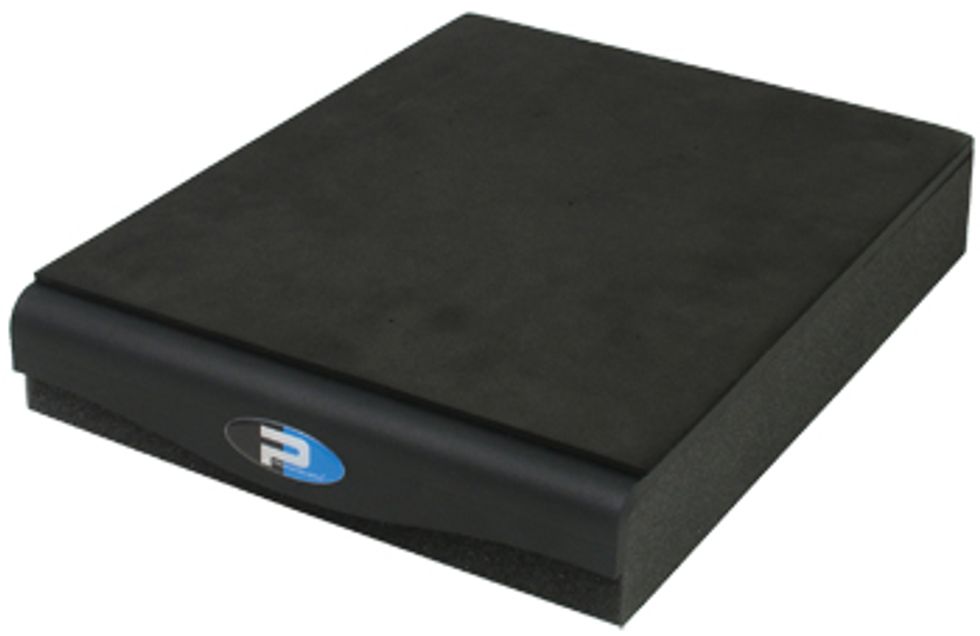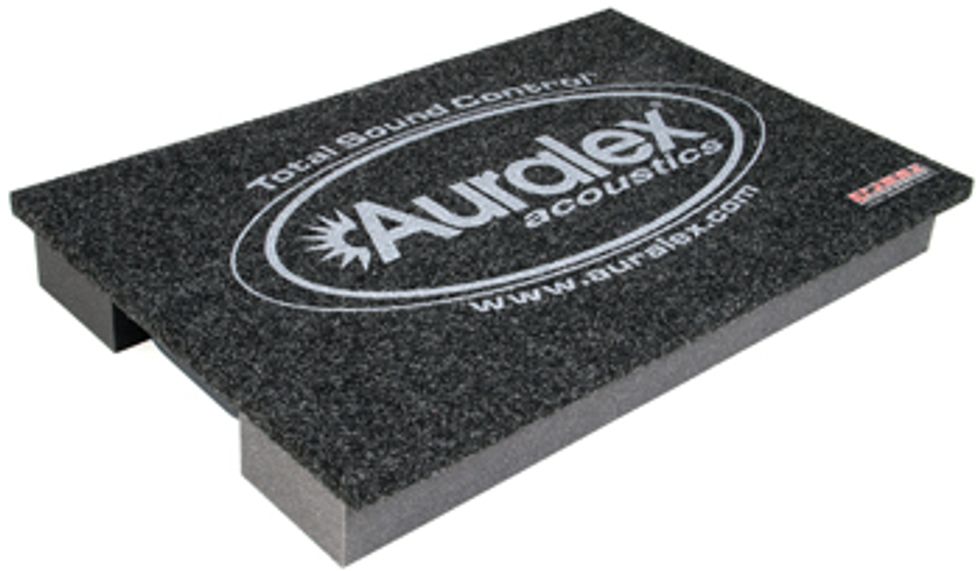Let’s talk about how to put the four components of sound control to work in keeping sound from escaping our studios and music rooms.

Primacoustic’s Recoil Stabilizers combine multiple layers of dense foam with a metal plate to isolate studio monitors from stands or desks.

An amplifier isolator such as the Auralex GRAMMA will cut down on vibrations being transferred into the floor.
In last month’s column, Keeping the Peace, Pt. 2, we discussed the four components of sound control: mass, decoupling, air space, and tight seals. This month, let’s talk about how to put these components to work in keeping sound from escaping our studios and music rooms. Which component(s) you can use ultimately depends on your particular situation. If you are renting an apartment, for example, adding mass to the walls by installing a second layer of drywall would probably be in direct violation of your lease agreement!
Isolate It
The easiest way to prevent sound escape is
decoupling, or isolating the sound sources
that could potentially transmit sound out of
the room. A combo amp or speaker cabinet
sitting directly on the floor will transfer
vibrations into the floor, and then into the
structure of the building. Yes, placing the
amp or cabinet on a solid, concrete floor—such as in a basement—will isolate it. But
an amp or cab in an upstairs bedroom needs
to be isolated from the floor. And heavy,
dense foam underneath will do the trick. If
you prefer a ready-made solution, check out
the isolation devices from companies such
as Auralex and Primacoustic.
You can also isolate studio monitors from the stands they sit on. I’ve used dense foam items such as mouse pads for this purpose. But again, there are some ready-made (and possibly better performing) monitor-isolation solutions from Primacoustic, Auralex, and other companies.
Seal It Up
It’s important to understand that sound can
escape through the tiniest of holes. If air can
get through, then sound can get through.
The first thing to do is check all the possible
places in your room where sound
could escape. And the first and often worst
offender is the door. Doors connecting to
outside spaces generally seal fairly tight
(or they should). But interior doors, such
as those into a bedroom or den—or even those into an apartment from a hallway—rarely close tightly all the way around.
Installing weather stripping around the
perimeter of the doorframe is a good way to
start, and really isn’t that difficult. It’s also
fairly easy to reverse should you need to.
The tough part with doors is typically sealing them underneath. External doors usually have a sill at the base and some sort of weather seal on the bottom of the door. Doors in professional studios often have some sort of heavy, spring-loaded seal that drops down when the door is closed. So what do you do about the door on the bedroom you use for your studio? Seal it up as tight as you can by stuffing a heavy towel, foam rubber, or whatever else you can find down there.
Windows are another source of sound escape. Heavy curtains will help, but stuffing the window opening with dense foam will be better. Another good solution is cutting a piece of plywood to fit the window opening, and then wrapping the edges of the plywood in soft material to protect the window frame. The tighter it fits, the better the seal will be.
Let’s not forget about heating and air-conditioning vents, and air returns. Blocking the vents will prevent air—and therefore sound—from escaping into the ductwork and propagating through the building. Just remember to uncover them when you’re finished making music so the air and heat can flow again!
Space It Out
Air space helps to reduce the transference
of vibrations. While moving the walls of your home might be a bit too challenging,
you can choose your music room/space so
that it is positioned as far as possible from
those who might be annoyed by your music
making. For example, if your bedroom is
directly under someone else’s bedroom,
playing music late at night in your room
could certainly be a problem. But choosing
the farthest corner of the basement, isolating
your amp, and sealing the door opening
just might make everyone happy.
Mass
Unless you are building from scratch or are
willing to remodel to a substantial degree,
adding mass to the walls and ceiling of your
music room or studio probably isn’t in the
cards. If you are heading in that direction,
consulting one of the many books or websites
on the subject of studio construction
would be a good place to start. Or, if your
budget allows, consult an acoustician for
suggestions on how to proceed.
Containing sound can be quite a challenge. But paying attention to sealing up your studio or music space, isolating sound sources, keeping sound sources as far as possible from potentially unwilling listeners, and adding mass to your space—if you can—will go a long way toward reducing noise complaints. Combine these components with some of the volume-reduction suggestions we discussed in the April 2013 issue, and you’ll be able to play your guitar without having to worry about offending family and neighbors.
Mitch Gallagher is
the former editor in chief of
EQ magazine. He’s written
more than 1,000 articles
and six books on recording
and music technology, and
has released an instructional
DVD on mastering. His upcoming book is
entitled Guitar Tone: Pursuing the Ultimate
Electric Guitar Sound. To learn more, visit

